
In the world of SEO, not all backlinks are created equal. Just as a well-chosen product name can make or break a product’s success, a quality backlink can significantly impact your website’s performance. But how do you determine if a backlink is worth pursuing?
In 2024, where digital visibility can mean the difference between thriving and just surviving, understanding what makes a backlink valuable is crucial. You shouldn’t settle for just any backlink.
This guide will walk you through the key aspects to check when evaluating potential link-building targets. We’ll break down the process, using SEMRush screenshots to make it crystal clear. By the end, you’ll know exactly what to look for to ensure your backlinks are worth their weight in gold, and avoid the ones that might do more harm than good. So, grab your SEO toolkit and let’s get into it!
Understanding Link Quality
When it comes to improving your site’s SEO, not all backlinks are created equal. Understanding what makes a backlink high-quality is crucial for effective link building.
A high-quality backlink is a link from another website that provides significant value to your own site’s search engine optimisation. This value comes from the link’s ability to pass along authority, relevance, and credibility, which can enhance your site’s ranking in search engine results.
Key characteristics of valuable backlinks:
- Relevance
- Authority
- Trustworthiness
- Placement
- Traffic potential
- Longevity
No-Follow vs. Do-Follow Backlinks: What’s the Difference?
When it comes to backlinks, understanding the difference between no-follow and do-follow links is vital for a balanced and effective SEO strategy. Here’s a rundown of what each type is:
| Aspect | Do-Follow Backlinks | No-Follow Backlinks |
| Definition | Links that pass SEO value (“link juice”) to the linked page. | Links that do not pass SEO value to the linked page. |
| SEO Impact | Contribute to the linked page’s search engine ranking. | Do not affect the linked page’s ranking directly. |
| Purpose | Boosts the authority and visibility of the linked page. | Primarily used for driving traffic and diversifying link profiles. |
| Typical Use | Found in editorial content, guest posts, and high-quality directories. | Often found in comments, forums, and some social media links. |
| Risk of Penalty | High if acquired through manipulative practices or low-quality sources. | Low risk as it doesn’t pass SEO value. |
A natural backlink profile usually includes a mix of both no-follow and do-follow links. Search engines like Google aim to mimic the natural web ecosystem, where not all links are intended to influence rankings. Here’s why balancing the two types is essential:
- Natural link profile: A healthy backlink profile reflects how the web naturally operates. Sites typically receive a variety of link types, so having both no-follow and do-follow links helps in appearing more natural and trustworthy to search engines.
- Avoid penalties: Relying solely on do-follow links or only on no-follow links might look suspicious to search engines. A balanced profile helps avoid any potential penalties that might arise from unnatural linking patterns.
- Holistic SEO strategy: Including no-follow links as part of your strategy ensures you’re not overly focused on just one aspect of SEO. This broader approach can lead to more robust and sustainable SEO performance.
Criteria for Evaluating Link-Building Targets
Domain Authority (DA)
When evaluating whether a website is worth getting a backlink from, one of the first things to check is its domain authority. This metric, typically measured on a scale from 1 to 100, reflects the overall strength of a website’s domain in terms of its ability to rank in search engine results. Essentially, it’s like a popularity score for a website, and it can give you a quick snapshot of its SEO potential.
Domain authority (DA) is a score developed by SEO tools like SEMrush that predicts how well a website will rank on search engine results pages (SERPs). A higher DA means a greater likelihood that the site ranks well and passes on more SEO value to your site through a backlink.
For example, if you’re looking at a site with a DA of 90, it’s generally seen as more authoritative compared to a site with a DA of 30. This means that a backlink from a high DA site is more valuable and likely to have a bigger impact on your SEO.
How to Check Domain Authority
You can use tools like SEMrush to find out a website’s DA. Here’s a quick guide:
- Open SEMrush
- Click “Domain Overview” in the left-hand menu
- Enter the Website URL and click “Search”
- In the “Overview” tab you should see the “Authority Score”
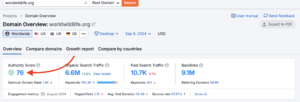
Top tip: Look at the DA of competing sites to understand where the website stands in comparison. You might thing your DA is low but compared to others in your industry you may be on top.
Why Domain Authority Matters
- Quality over quantity: A backlink from a high DA site is often worth more than multiple backlinks from lower DA sites. This is because high DA sites are seen as more trustworthy and influential by search engines.
- Impact on search rankings: Higher DA sites generally have a better chance of ranking well for competitive keywords, so a backlink from such a site can contribute more significantly to improving your own search rankings.
- Trust and credibility: High DA sites are often seen as more reputable. Getting a backlink from such a site can enhance your credibility and authority in your niche.
While DA is a useful metric, it’s not the only one you should consider. A high DA site might still have other issues, such as irrelevant content or a poor user experience. Additionally, DA is just a predictive metric and doesn’t guarantee actual search engine ranking performance.
Relevance to Your Niche
When it comes to link-building, relevance is king. A backlink from a site related to your niche is far more valuable than one from an unrelated source. Why? Because search engines, like Google, prioritise links that come from sites with content relevant to your own.
This relevance helps establish your site’s authority in its specific area, improving its ranking potential. A relevant backlink not only signals to search engines that your content is credible but also ensures that the traffic coming from that link is genuinely interested in what you have to offer.
To evaluate the relevance of a backlink, start by analysing the content and niche of the linking site. Ask yourself these questions:
- Is the linking site in the same industry or field as your site? For instance, a backlink from a health blog is more relevant to a fitness website than one from a technology site. Similarly, when discussing topics like the best EHR for small practices, backlinks from reputable healthcare or medical blogs will be far more valuable than links from unrelated websites or industries.
- What is the context of the backlink? Ensure that the link is placed within content that is relevant to your topic. A link embedded in a blog post about fitness is more valuable than one in a general article.
- Check the linking site’s categories or tags. These should align with your niche to confirm relevance.
Traffic and Engagement Metrics
High traffic and strong user engagement are indicators of a website’s popularity and authority. Websites with substantial traffic and high engagement levels typically offer high-quality content and a positive user experience. Links from such sites can drive significant referral traffic to your site and improve your own site’s credibility and ranking potential. Engaged users are more likely to interact with the content, leading to better visibility and potential for higher rankings.
How to Assess These Metrics with SEMRush
SEMRush provides valuable tools for assessing traffic and engagement metrics:
1. Traffic overview: Use SEMRush’s”Traffic Analytics” in the left-hand side menu to check the estimated traffic for the linking site. “Organic Research” or “Domain Overview” (also in the left-hand menu) can give you insights into organic traffic. Higher traffic suggests a more authoritative site.
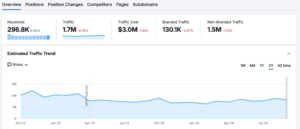
2. Engagement metrics: Look at metrics like average session duration and pages per session. High values indicate strong user engagement. SEMRush’s “Traffic Analytics” in the left-hand menu can provide insights into metrics such as pages per visit, average visit duration and bounce rate.
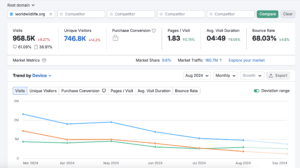
3. Competitor analysis: Compare the linking site’s traffic and engagement with competitors in your niche. This helps gauge whether the site is a leading player in your field. You can do this in the “Traffic Analytics” tab on SEMrush by simply adding your competitor URLs and clicking “Compare”.

Toxicity Score and Link Profile
A toxicity score is a metric used to evaluate the likelihood of a website being penalised by search engines for spammy practices. A high toxicity score indicates that the site might have engaged in dubious SEO tactics or has low-quality backlinks, which can potentially harm your site’s SEO if you link to it.
While we think toxicity and spam scores are still important to be aware of when choosing a website to get a link from. It’s important to note that Google has said you don’t need to fret about them in regards to your own website. After all, this is just a metric made by the developers of third-party tools and not from Google itself.

How to Identify Spammy Sites
To identify spammy sites, consider the following:
1. Toxicity score: Use tools like SEMRush to check the toxicity score of the linking site. A high spam score is a red flag. Click “Backlink Analytics” in the left-hand menu, enter the URL, click “Analyze” and you’ll see your “Overall Toxicity Score” appear on the right-hand side of the screen.
2. Network graph: Click “Backlink Analytics” in the left-hand menu, enter the URL, click “Analyze” and you’ll see a graph appear below the toxicity score that looks like an interconnected web of nodes. This will tell you whether the backlinks from that website are relevant to it. A red network graph could indicate that they are building backlinks from link farms and are trying to manipulate the search engine results.
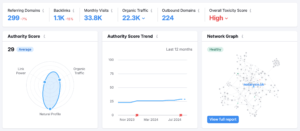
3. Link profile analysis: Examine the backlink profile of the linking site. If it has numerous low-quality, irrelevant, or paid links, it’s likely to be spammy. Click “Backlink Analytics” in the left-hand menu, enter the URL, click “Analyze” and then click the “Backlinks” tab to get an in-depth view of the linking websites.
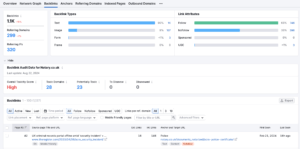
4. Content quality: Review the quality of content on the site. Spammy sites often have poor, irrelevant, or thin content. All you really need to do to check this is open the website, click on a couple of blog posts and then let your intuition do the rest.
Trustworthiness and Domain Age
Trustworthiness and domain age are crucial for determining the value of a backlink. Trustworthy sites are more reliable sources of information and are less likely to engage in spammy practices. Domain age can also be an indicator of a site’s stability and credibility. Older domains generally have a more established reputation, which can positively influence the credibility of the backlinks they provide.
How to Evaluate These Factors
To evaluate the trustworthiness and domain age:
- Trustworthiness: Check the site’s reputation through reviews, user feedback, and its presence in authoritative directories.
- Domain age: Use WHOIS lookup tools to find out when the domain was registered. Older domains are typically more reliable.
- Site authority: Look at metrics such as Domain Authority on SEMRush to gauge the overall trustworthiness and strength of the domain.
3 Common Red Flags to Avoid
1. Low-Quality or Irrelevant Content
When evaluating potential backlink sources, the quality of the content on the linking site is crucial. Backlinks from sites with low-quality or irrelevant content can harm your SEO efforts. Here’s what to look out for:
- Poor content quality: Sites with thin, poorly written, or irrelevant content may not offer much value. If the content doesn’t provide meaningful information or seems to be hastily put together, the backlink may not be beneficial.
- Relevance issues: Ensure the content where your backlink is placed is related to your niche. Links from sites with content that’s unrelated to your topic are less valuable and may even look suspicious to search engines.
- Content scraping: Be wary of sites that appear to scrape content from other sources rather than creating original material. These sites often lack credibility and can negatively impact your link profile.
- Purely AI-generated content: Tools like ChatGPT can be great for content creation when used in moderation but when used to pump out hundreds of articles daily you’ll notice the content decreasing and they’ll read as if written by a robot.
2. Excessive Ads or Pop-Ups
Websites cluttered with excessive ads or intrusive pop-ups can be problematic. Sites overloaded with ads or pop-ups offer a poor user experience, which can reflect negatively on your site if you’re linked from such pages. Search engines prioritise user experience, so linking from such sites may impact your rankings.
A site that prioritises ads over content may be considered less credible. Excessive advertising can be a red flag indicating a site is more interested in generating revenue than providing value, which can affect the quality of the backlinks.
3. High Spam Scores or Suspicious Link Profiles
A high spam score or a suspicious link profile can signal potential issues with a backlink source. Here’s what to watch for:
- High spam score: Use tools like SEMRush to check the spam score of the linking site. A high spam score indicates the site may be involved in questionable practices or may have low-quality backlinks. This can be harmful to your SEO if you’re associated with it.
- Suspicious link profiles: Examine the link profile of the linking site. If it shows a large number of low-quality, irrelevant, or paid links, it could be considered spammy. Such sites may have used manipulative tactics to boost their rankings, which can be detrimental to your own site’s SEO.
- Unnatural link patterns: Look for unnatural link patterns, such as a sudden spike in the number of backlinks, disproportionately more do-follow backlinks, or a high proportion of links from unrelated or low-quality sites. This can indicate manipulative practices or a link scheme that could harm your site’s credibility.
Keep Your Backlink Game Strong
Evaluating backlink opportunities involves several crucial factors to ensure you’re improving your site’s SEO. First, prioritise the relevance of the linking site to your niche. Backlinks from sites with content closely related to your own are far more valuable. Next, assess traffic and engagement metrics; higher traffic and better user engagement often indicate a site with a solid reputation and a strong audience.
Be mindful of spam scores and link profiles. Avoid sites with high spam scores or those showing suspicious link patterns, as these can negatively impact your SEO. Finally, consider trustworthiness and domain age; older, more established sites are generally more reliable and beneficial for your backlink profile.
Maintaining a healthy backlink profile requires ongoing attention. Regularly audit your backlinks to ensure they align with your SEO goals and remain free of red flags like low-quality content or excessive ads. Keep your content relevant and engaging to attract high-quality backlinks naturally. Use tools and analytics to monitor your backlink profile and make adjustments as needed to avoid penalties and keep your SEO strategy on track.



